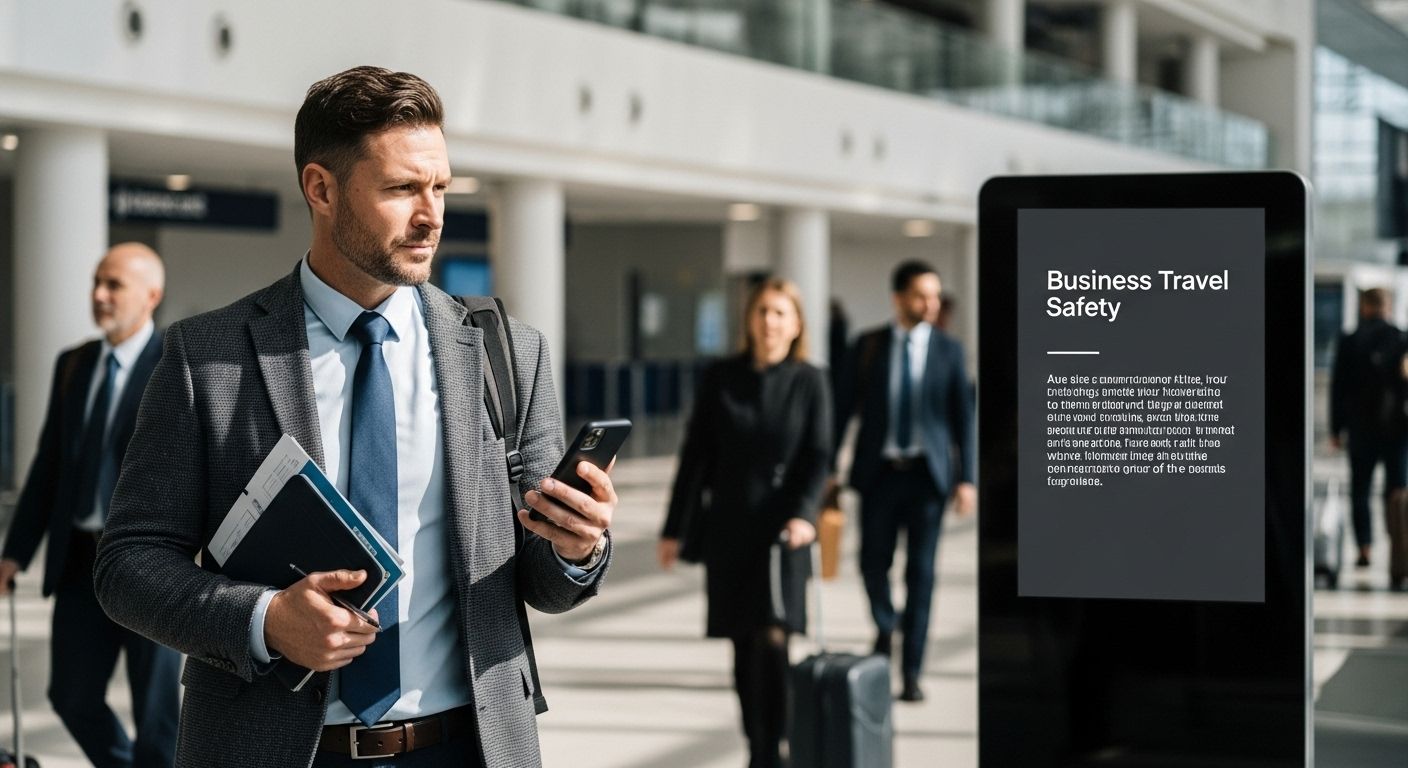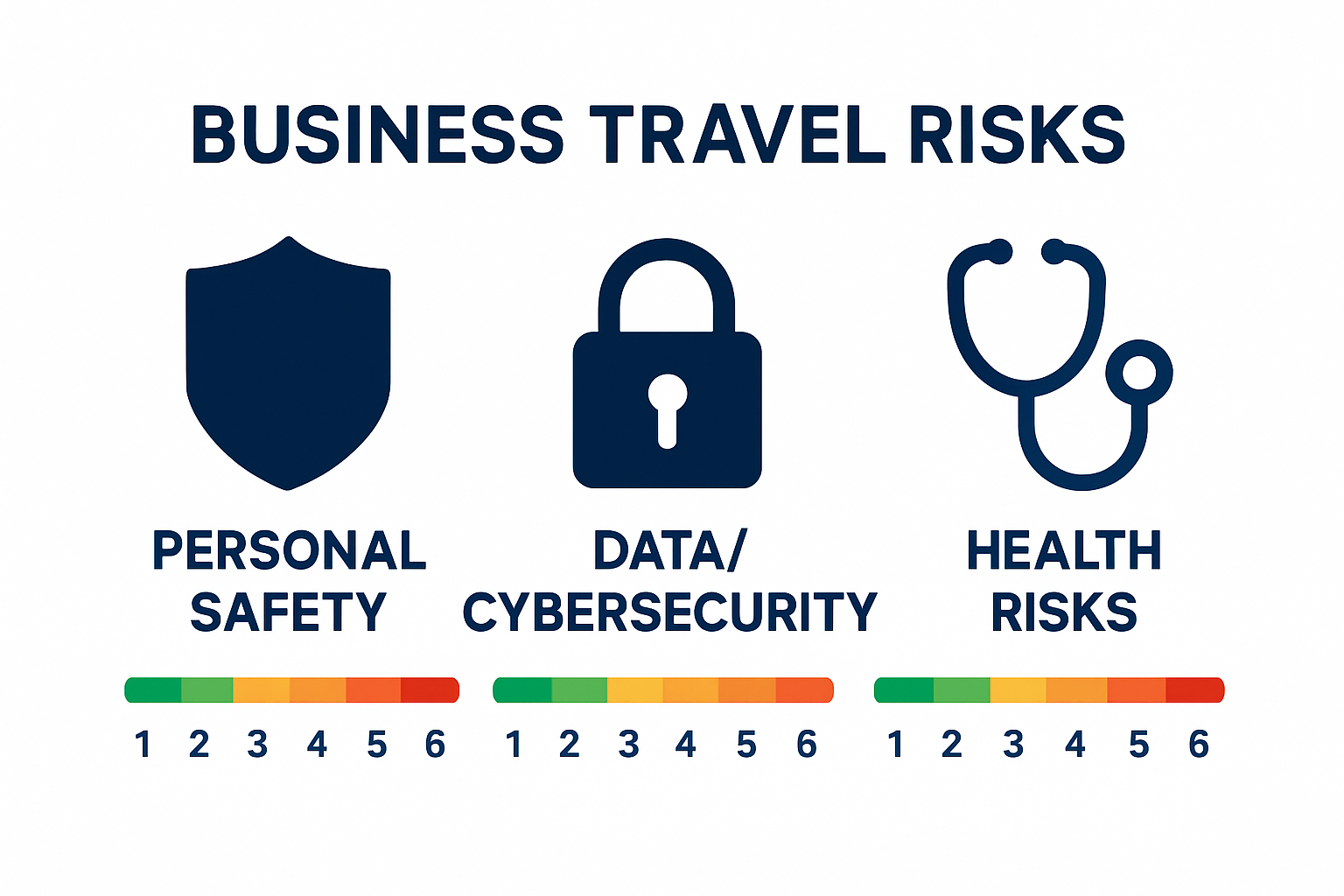Understanding Business Travel Safety Tips for Success
- info1419758
- 7 hours ago
- 8 min read

Corporate travel can feel routine until you look closer. The CDC reports that international business travelers face much higher risks for health issues and stress than typical vacationers. Most people only think about booking flights and hotels. Few realize that one missed detail in safety planning can change everything. It is the behind-the-scenes precautions that decide whether a trip is just productive—or unexpectedly dangerous.
Table of Contents
Quick Summary
Takeaway | Explanation |
Prioritize comprehensive preparation for travel | Invest time in researching risks, local laws, and cultural norms to enhance safety while traveling. |
Implement clear communication protocols | Establish reliable channels for check-ins to ensure quick responses in emergencies during international trips. |
Utilize travel insurance effectively | Secure appropriate insurance coverage to protect against potential health and financial risks encountered abroad. |
Focus on situational awareness | Maintain vigilance regarding surroundings and potential threats to personal security while navigating unfamiliar environments. |
Understand cultural differences and dynamics | Adapt to local customs and legal practices to mitigate risks and promote effective business interactions during travel. |
What Are Business Travel Safety Tips and Why Are They Important?
Business travel involves complex logistics and potential risks that extend far beyond standard vacation travel. Safety becomes paramount when professionals navigate unfamiliar environments, handle sensitive company information, and represent their organization globally.
Understanding Business Travel Risk Landscape
Business travelers encounter unique safety challenges that differentiate them from leisure travelers. These risks include potential threats to personal security, financial vulnerability, data protection concerns, and unexpected health emergencies. According to the U.S. Department of State, comprehensive preparation is crucial for mitigating potential risks during international business travel.

Key risk areas for business travelers include:
Personal physical safety in unfamiliar locations
Potential theft of company or personal electronic devices
Financial security and protection against fraud
Health risks in regions with different medical standards
Potential cybersecurity vulnerabilities
Strategic Importance of Travel Safety Protocols
Business travel safety tips are not mere recommendations but strategic imperatives for organizations. Companies invest significantly in travel protocols to protect their employees, maintain operational continuity, and safeguard corporate reputation. Effective safety strategies help professionals navigate complex international environments while minimizing potential disruptions.
A comprehensive business travel safety approach encompasses multiple dimensions:
Proactive risk assessment before travel
Clear communication and emergency contact protocols
Comprehensive travel insurance coverage
Technology and data protection strategies
Cultural awareness and situational adaptability
By understanding and implementing robust business travel safety tips, professionals transform potential vulnerabilities into opportunities for confident, secure, and successful international business engagement.
The table below summarizes the main types of business travel risks and provides practical safety strategies for each category.
Risk Category | Description | Key Safety Strategy |
Personal Physical Safety | Exposure to unfamiliar locations and lone travel | Research locations and plan safe routes |
Theft of Devices | Risk of losing company or personal electronics | Use secure bags and never leave items unattended |
Financial Security | Potential exposure to scams or fraud abroad | Set up credit alerts and limit cash carried |
Health Risks | Exposure to new diseases and limited medical access | Obtain travel insurance and vaccinations |
Cybersecurity Vulnerability | Data theft or hacking in insecure environments | Use VPN and avoid public Wi-Fi networks |
The Impact of Safety on Business Travel: Risks and Benefits
Business travel safety transcends simple precautionary measures and represents a critical strategic consideration for modern organizations. The complex interplay between personal risk, corporate responsibility, and operational effectiveness demands a nuanced understanding of travel safety implications.
Health and Wellness Risks in Business Travel
According to the CDC, international business travelers face significant health challenges that extend beyond typical travel concerns. Prolonged travel and exposure to diverse environments can dramatically impact an individual’s physical and mental well-being.
Key health risks associated with business travel include:
Increased stress and potential mental health strain
Higher susceptibility to infectious diseases
Disrupted sleep patterns and circadian rhythm challenges
Potential exposure to environmental health hazards
Compromised nutrition and exercise routines
Organizational Risk Management and Strategic Implications
Business travel safety is not merely an individual concern but a critical organizational strategy. Companies must proactively develop comprehensive risk management frameworks that protect employee welfare while maintaining operational effectiveness. This approach involves balancing employee protection with business objectives, understanding potential legal and financial consequences of inadequate safety protocols.
Strategic considerations for organizational travel safety include:
Developing robust travel risk assessment protocols
Implementing comprehensive insurance and emergency response plans
Creating clear communication channels during international travel
Investing in employee training for situational awareness
Establishing transparent reporting mechanisms for potential risks
By recognizing business travel safety as a holistic ecosystem of personal, technological, and organizational factors, companies can transform potential vulnerabilities into opportunities for strategic resilience and employee empowerment.
Key Concepts in Business Travel Safety: Preparation, Awareness, and Communication
Effective business travel safety requires a holistic approach that integrates strategic planning, situational awareness, and robust communication protocols. Professionals must develop a comprehensive mindset that anticipates potential challenges and creates adaptive strategies for managing unexpected scenarios.
Strategic Preparation and Risk Assessment
According to UC Davis Global Affairs, comprehensive preparation is the cornerstone of successful business travel safety. This involves meticulously researching destination-specific risks, understanding local cultural nuances, and developing contingency plans that address potential vulnerabilities.
Key preparation strategies include:
This table organizes the core elements of business travel preparation to help travelers plan and minimize common risks.
Preparation Element | Key Focus | Example Action |
Destination Research | Understanding local risks and political environment | Review travel advisories and news |
Documentation & Backups | Ensuring access to critical information | Scan passports and share copies securely |
Route & Transport Planning | Mapping out reliable travel and transit options | Plan routes using trusted transportation providers |
Emergency Contacts | Knowing how to access help quickly | Save embassy and local emergency numbers |
Insurance Coverage | Protecting against health and travel-related losses | Purchase comprehensive travel insurance |
Thorough research of destination political and social environments
Comprehensive documentation and backup of critical travel information
Advanced mapping and transportation route planning
Understanding local emergency contact procedures
Securing appropriate travel insurance coverage
Communication and Real-Time Awareness Protocols
Effective communication represents the lifeline of business travel safety. Modern professionals must establish clear, reliable communication channels that enable rapid information exchange and emergency response. This involves leveraging technology, maintaining multiple communication backup systems, and creating transparent reporting mechanisms.
Communication strategies encompass:
Establishing regular check-in protocols with home office
Utilizing secure communication platforms
Learn more about managing unexpected situations during business travel and develop robust emergency response capabilities.
By integrating preparation, awareness, and communication, business travelers transform potential risks into manageable challenges, ensuring personal safety and operational continuity in dynamic international environments.

Real-World Context: Case Studies in Business Travel Safety
Business travel safety is not an abstract concept but a critical operational requirement that demands practical understanding through real-world scenarios. Analyzing actual case studies provides invaluable insights into the complex dynamics of managing risks during professional international travel.
Technology and Data Protection Challenges
According to the U.S. Department of State, international business travelers face significant technological vulnerabilities that require strategic mitigation. Documented case studies reveal recurring patterns of potential security breaches and operational risks.
Common technological safety scenarios include:
Corporate device theft in high-risk transportation zones
Unauthorized network access in public wireless environments
Sophisticated phishing attempts targeting traveling professionals
Potential data interception during international telecommunications
Cybersecurity risks in countries with limited digital protection regulations
Emergency Response and Organizational Resilience
Successful business travel safety transcends individual preparedness and requires robust organizational frameworks that enable rapid, coordinated responses to unexpected challenges. Professional organizations have developed comprehensive strategies to address potential emergency scenarios.
Key organizational response strategies demonstrate:
Rapid communication protocols during critical incidents
Comprehensive employee tracking and support systems
Legal and financial contingency planning
Mental health support for employees experiencing travel-related stress
Adaptive risk management approaches
Explore advanced emergency management techniques to enhance your organization’s travel safety capabilities. By understanding these real-world contexts, businesses can transform potential vulnerabilities into opportunities for strategic resilience and proactive risk management.
Navigating Global Risks: Understanding Cultural and Regional Safety Practices
Business travel safety extends far beyond technical precautions and encompasses a profound understanding of diverse cultural landscapes and regional risk dynamics. Professionals must develop nuanced awareness that transcends generic safety protocols and adapts to specific geographical and cultural contexts.
Cultural Intelligence and Risk Perception
According to the U.S. Department of State, effective global risk navigation requires comprehensive cultural intelligence that goes beyond surface-level understanding. Different regions present unique safety challenges that demand sophisticated, context-specific approaches.
Key cultural risk factors include:
Variations in local legal interpretations and enforcement practices
Nonverbal communication nuances that impact personal safety
Regional differences in acceptable professional behaviors
Understanding unwritten social hierarchies and interaction protocols
Local perceptions of personal space and interpersonal boundaries
Regional Safety Ecosystem Analysis
Safety is not a universal concept but a complex ecosystem influenced by geopolitical, economic, and social factors. Business travelers must develop adaptive strategies that recognize the intricate interplay between local conditions and potential risks.
Comprehensive regional safety considerations encompass:
Geopolitical stability and potential conflict zones
Economic infrastructure and local crime patterns
Healthcare system capabilities and emergency response mechanisms
Transportation safety standards and infrastructure reliability
Technological connectivity and digital security landscape
Learn advanced emergency management techniques to enhance your global risk navigation capabilities. By understanding these nuanced cultural and regional safety practices, professionals can transform potential vulnerabilities into strategic advantages, ensuring safe and successful international business engagement.
Secure Your Business Shoots With Trusted Local Experts
Business travel means navigating risks that go far beyond personal safety. The article highlights how international teams face stress over logistics, complex permits, and local security every time they travel to a new environment for work. These pain points are true for traveling film crews and business content creators who cannot afford mistakes when on a tight shoot schedule. A single delay or an overlooked risk can impact your project and your team’s well-being.

With Video Production Switzerland, you never have to worry about business travel uncertainties or unexpected hurdles. Our local crew manages every detail from permits to transportation, so you focus on your creative vision instead of stress. Ready to work with a team that puts your safety, logistics, and peace of mind first? Start your seamless video production journey here and discover why leading brands trust our 20 years of expertise. Let us help transform travel challenges into smooth, successful productions. Visit our main site and take action today.
Frequently Asked Questions
What are the key safety risks associated with business travel?
Business travelers face unique risks, including personal physical safety, theft of electronic devices, financial security, health risks, and cybersecurity vulnerabilities.
How can companies enhance the safety of their employees during business travel?
Companies can enhance employee safety by developing comprehensive travel risk assessment protocols, providing clear communication channels, ensuring travel insurance coverage, and investing in employee training for situational awareness.
Why is cultural awareness important in business travel safety?
Cultural awareness is crucial because different regions have unique safety challenges and social norms that can impact personal safety. Understanding local customs can help travelers navigate potential risks more effectively.
How can travelers prepare for unexpected health emergencies while traveling?
Travelers can prepare by researching destination-specific health risks, having appropriate travel insurance, knowing local healthcare facilities, and ensuring access to essential medications and vaccinations.
Recommended

Comments